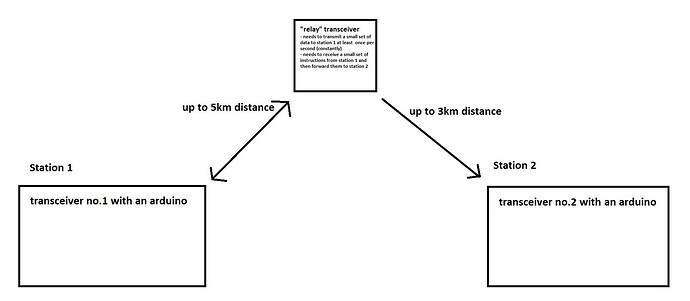I am currently considering different solutions for my project, which bases itself on full-duplex communication between two Arduinos (2xnano every or 2xpro micro). To do that, I would need radio modules operating on 433 MHz. At first, the NRF905 seemed like a good option but the reach is slightly lacking (I need around 5km of guaranteed reach). On the other hand, using two, half-duplex Lora SX1278 or RMF95 modules is overly complicated and takes too much space. Are there any other alternatives to the NRF in that case? Especially with a longer reach and stronger transmitting and receiving frequencies (20dbm, -150dbm would be ideal).
You need to change your expectations. NO radios will operate FULL DUPLEX on the same frequency band. One transmitting will completely disable the one receiving. You will need to use frequencies VERY far apart plus filters to limit the RF bandwith being received. ALL transmitters produce noise signals far away in frequency from the main transmit frequency and that noise must not get to the adjacent receiver.
Moreover, ONE Arduino is not capable of handling transmitting at the same time as receiving. So you would need to coordinate TWO Arduinos at each end of the communications path.
How much data and how fast are you sending it?
I am in the EU, so the standard frequency for such projects is 433 Mhz
Very little, it's about sending short commands to a small scale robot on a large distance (5.5km) through a arduino powered satellite, a few kilometers in the air
Why does that need to be full duplex?
through a arduino powered satellite
Please describe. This requires two more radio channels, for full duplex; a very complex and expensive setup.
They will operate with a +-125kHz frequency difference. Will that be enough? And maybe I explained poorly - I wanted one arduino and one full duplex receiver on both ends. Here, the full duplex does not mean that I have constant, both way communication. Rather, that transceiver will switch between the roles of transmitting and receiving a few times per second (like the NRF), without requiring two arduinos and two radio modules (like the Lora). Yet, I would need it to be as strong as possible
Please post a diagram of the setup. Your written explanation is unclear.
"LoRa" is just a modulation method. The same number of radios is required, regardless of the modulation method.
Because the station 1 requires to know the position (height) of the satellite at least once per second. This needs to happen while the satellite is also 1) receiving data from station 1; 2) transmitting that data so station 2.
Therefore, I do not need a full duplex module which will operate as a transceiver all the time, rather one that is able to switch between the roles at least a number of times within a second
If i have a half-duplex, i will need two modules on the satellite and I don't have enough space or weight for that. Therefore I am trying to maximise the possibility of 2-way communication, when keeping the weight and volume rather low
Then use the proper designation: simplex. meaning exactly what those devices are designed to do. Remember they are transceivers and send an acknowledgement to the sending unit which has to receive that to complete the message transmission.
You are describing simplex, there is a big difference and in your case that will probably cut the cost by over 50%. Simplex indicates that it can only send or receive but not at the same time. The transceivers you mention will transmit or receive but not concurrently. Study the data sheet on them and look at a few examples on this forum.
You are planning on use the ISM frequencies, so please study the rules for that and memorize them. There are transmission time length and how often. There are antenna type limits and limits to ERP or effective power coming from the antenna. Only then can you look at the data sheets for devices and determine if they meet the requirements for your country.
Finally, set up reasonable test for the communications before expending time and money on the rest of your system.
Describing the actual project would help.
Please explain why ?
And what and where is this 'satellite' ?
If you are really and truly working on a device to be launched toward space, then you MUST be aware that NONE of the ISM devices can be used!
This topic was automatically closed 180 days after the last reply. New replies are no longer allowed.
